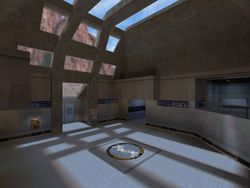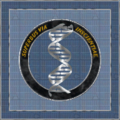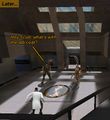Questionable Ethics
| This article would greatly benefit from the addition of one or more new images. | ||
|---|---|---|
Please upload one or several relevant images (from canonical / official sources) and place it here. Once finished, this notice may be removed. |

| |
| Questionable Ethics | |
|---|---|
| Game information | |
| Designer(s) | |
| Map(s) |
|
| Previous chapter | |
| Next chapter | |
Questionable Ethics is the eleventh chapter of Half-Life.
Contents
Overview[edit]
This chapter takes place in the Advanced Biological Research Lab.[2] The player learns that this is a facility devoted entirely to the study of captured alien creatures. The area is under the military's control. The main goal is to find a scientist with a retinal scanner access who can open the front door in the lobby, so the player can go outside and escape.
There are sterilization chambers,[3] which can be used from their booths to trap and kill the enemies by vaporizing them. There is a laser lab upstairs where the player is required to turn on four power sources for a red laser, and use the laser to carve through a wall. This leads to a room (dubbed "Psycho Surgery")[4] with three scientists and an out of control surgical unit. The player can have a scientist follow him to the lobby, and have him open the front door.
After opening the door, the scientist warns the player that outside is completely under military control. He says the player has to fight his way through to reach the Lambda Complex, where the rest of the science team has taken shelter. There is a path outside that leads to the Hydro-Electric Dam.
Development[edit]
Alpha[edit]
The Alien Research Lab is the predecessor of Questionable Ethics, and is the fourth chapter in the Alpha version of the game. It was also developed by Dario Casali. The chapter shares the same general premise. While none of the level architecture was reused, the concept of Alien Grunts being stored in containment chambers survived into the final game.
Retail[edit]
According to Marc Laidlaw, the labs served numerous purposes in the game: To deepen the sense of conspiracy and cause the player to question what was actually going on at Black Mesa; to give the player access to a high-powered weapon that's crucial for battling powerful enemies in subsequent levels; and to force a style of puzzle-solving focused on protecting and working with human characters (scientists) rather than simply throwing switches.
Goal: This section of the labs is quite non-linear in layout, although judicious use of locked doors again gives it a linear flow the first time through. Non-linear areas tend to work against the usual dramatic virtues of pacing and rhythm and timing, and give rise to plentiful opportunities for boredom and confusion. They also make it easy for the player to miss or forget his goal. When designing the labs on paper, they decided that the player should see his goal (the exit) immediately upon entering the lobby. There is a scanner next to the locked exist, and by this time the player has been taught that only scientists or other NPCs can operate a scanner. Presumably the player will carry this knowledge with him as he moves away from the exit and fights his way through the other areas of the map, and by the time he encounters a group of hiding scientists, he'll understand that he's supposed to escort one of them through the labyrinthine labs back to the scanner. To further aid the player in understanding the goal, they added a security guard to give a short briefing on the way into the area.
Gameplay: Puzzles were built around a variety of enemy encounters, traps, and scientific devices, and assembled from elements that have some logical place in the environment: sterilizers, laser equipment, caged monsters. Getting certain weapons is tricky in that it requires exposing oneself to monsters, and then quickly working with the environment to neutralize the threat. The player must open a cage full of sharks, then retreat into a sterilizer control room in order to vaporize them before he is overwhelmed. In addition, the presence of enemy soldiers adds a constant threat and gives contrast to the alien menace. In some circumstances, the canny player choose to wait out battles between aliens and other humans, and then deal with the weakened victor of those battles. In such cases, the player's best strategy is patience. This puts a twist on the unusual action game tactic, where players usually can expect to solve all problems by direct, aggressive attacks.
Atmosphere: They selected detail that seemed appropriate to the research environment, and that added to the underlying story. Certain areas were tailored specifically for the study of the alien creatures, which tends to raise questions about how long the researcher at Black Mesa have known about the aliens, and what exactly they were doing with them. As much as possible, the details also provided opportunities for gameplay; for instance, sterilizers that were used by researchers to cleanse room of biohazards turn out to be just as effective at vaporizing pursuing soldiers. Since they wanted a mood of high-tech horror to pervade Half-Life, they avoided a lot of opportunities for wacky comedy, and instead tried to set up situations for suitably dark and ironic humor. The "Tau Cannon", for instance, is given to the player at the end of a macabre sequence. And as a bonus, in addition to the weapon itself, the player is "rewarded" with a unique piece of music that punctuates the action and puts a weird spin on the otherwise relentless mood of horror.[5]
In the Net Test 1 Build, Drums and Riffs plays when Picking up the Tau Cannon which was replaced with Nuclear Mission Jam in the Final Game.
Other versions[edit]
The level code for the chapter in the Dreamcast version is "Regression Brings Progress".
Gallery[edit]
Pre-release[edit]
Retail[edit]
Other[edit]
It's a Wonderful Half-Life[edit]
Associated media[edit]
 Additional images related to Questionable Ethics
Additional images related to Questionable Ethics- Half-Life soundtrack
- Nuclear Mission Jam
- Dark Piano Short
References[edit]
- ↑ Interview with Dario Casali on Voltron's Map Workshop (May 1, 2000) (archived)
- ↑ Half-Life Prima Guide
- ↑ Half-Life (
sentences.txt) - ↑ The level plan for the laser puzzle
- ↑ Game Design: Secrets of the Sages by Marc Saltzman (1999)


























